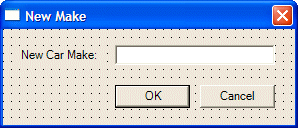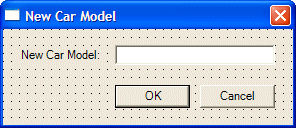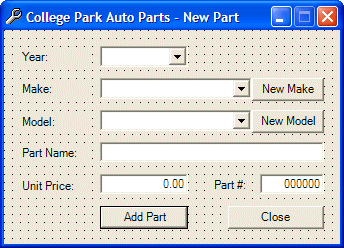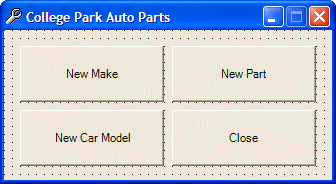
Operations on XML Elements
 |
Operations on XML Elements |
The easiest way to add text to an element, whether the element exists already or you want to add a new element, consists of manually opening the file and typing the text of the new element in the desired section. For example, you can click the Data button of the XML while opened in Visual Studio .NET:  If you click the empty cells and fill them up, if you save the file, the new elements would be added to the file.
To programmatically create a new element, you can declare an XmlElement variable. To add the new element to the file, the XmlDocument class provides the CreateElement() method that is overloaded with three versions. One of the versions uses the following syntax: Overloads Public Function CreateElement(ByVal name As String) As XmlElement Using this method, to create a new element, call it and pass it the name of the new element. If you want the element to have a value, the XmlDocument class is equipped with the CreateTextNode() method. This method returns an XmlText value. The syntax of this method is: Public Overridable Function CreateTextNode(ByVal text As String) As XmlText This method takes as argument the string that would constitute the value of the element. The calls to XmlDocument.CreateElement() and XmlDocument.CreateTextNode() allow you to initialize a new element. In order to actually add the new element, you must specify its position in the tree: whether it would be the first or the last node, whether you want to position it before or after a node of your choice. To support the positions of existing nodes, the XmlNode class, which is the ancestor of all XML nodes of the .NET Framework, provides various appropriate methods. One of these methods is AppendChild(), which is used to add an element as the last child of its parent. The syntax of the XmlNode.AppendChild() method is: Public Overridable Function AppendChild(ByVal newChild As XmlNode) As XmlNode Imagine you have a simple XML file that has only the root and one level of elements as follows: <?xml version="1.0" encoding="utf-8"?> <Holidays> <Holiday>New Year's Day</Holiday> <Holiday>Birthday of Martin Luther King, Jr.</Holiday> <Holiday>Washington's Birthday</Holiday> </Holidays> To add a new Holiday element to this file, based on the above discussions, you can use code as follows: |
Private Sub btnAddHoliday_Click(ByVal sender As System.Object, ByVal e As System.EventArgs) Handles btnAddHoliday.Click
Dim docXML As XmlDocument = New XmlDocument
docXML.Load("Holidays.xml")
Dim elmXML As XmlElement = docXML.CreateElement("Holiday")
Dim txtXML As XmlText = docXML.CreateTextNode("Memorial Day")
docXML.DocumentElement.AppendChild(elmXML)
docXML.DocumentElement.LastChild.AppendChild(txtXML)
docXML.Save("Holidays.xml")
End Sub
|
|
 |
||||||||||||||||||||||||
|
Private Sub btnNewMake_Click(ByVal sender As System.Object, ByVal e As System.EventArgs) Handles btnNewMake.Click
Dim strNewMake As String
Dim allMyChildren As String
Dim docXMLFile As New XmlDocument
Dim nodRoot As XmlElement
' The new car make will come from the New Make dialog box
Dim frmMake As NewMake = New NewMake
' Display the New Make dialog box and find out if the user clicked OK
If frmMake.ShowDialog() = DialogResult.OK Then
strNewMake = frmMake.txtNewMake.Text
' If the New Make string is empty, don't do anything
If strNewMake = "" Then
Exit Sub
End If
' Open the Makes.xml fill
docXMLFile.Load("Makes.xml")
' Get the root node so we can explore its children
nodRoot = docXMLFile.DocumentElement
' Store all the values of the elements in a string
allMyChildren = nodRoot.InnerText
' Locate the new make among the values of the elements
Dim indexLookForNewMake As Int32 = allMyChildren.IndexOf(strNewMake)
' If the car make exists already, don't add it
If indexLookForNewMake >= 0 Then
Exit Sub
Else
' If the car is not in the list already, add it as a Make element
Dim elmXML As XmlElement = docXMLFile.CreateElement("Make")
' Create its value using the string from the New Make dialog box
Dim txtXML As XmlText = docXMLFile.CreateTextNode(frmMake.txtNewMake.Text)
' Add the new element at the end of the file
docXMLFile.DocumentElement.AppendChild(elmXML)
' Specify its text
docXMLFile.DocumentElement.LastChild.AppendChild(txtXML)
' Save the file
docXMLFile.Save("Makes.xml")
End If
End If
End Sub
|
 |
||||||||||||||||||||||||
|
Private Sub btnNewModel_Click(ByVal sender As System.Object, ByVal e As System.EventArgs) Handles btnNewModel.Click
' The new car make will come from the New Make dialog box
Dim frmModel As New NewModel
' Display the New Make dialog box and find out if the user clicked OK
If frmModel.ShowDialog() = DialogResult.OK Then
Dim strNewModel As String = frmModel.txtNewModel.Text
' If the New Make string is empty, don't do anything
If strNewModel = "" Then
Exit Sub
End If
' Open the Makes.xml file
Dim docXMLFile As New XmlDocument
docXMLFile.Load("Models.xml")
' Get the root node so we can explore its children
Dim nodRoot As XmlElement = docXMLFile.DocumentElement
' Store all the values of the elements in a string
Dim allMyChildren As String = nodRoot.InnerText
' Locate the new make among the values of the elements
Dim indexLookForNewModel As Int32 = allMyChildren.IndexOf(strNewModel)
' If the car make exists already, don't add it
If (indexLookForNewModel >= 0) Then
Exit Sub
Else
' If the car is not in the list already, add it as a Make element
Dim elmXML As XmlElement = docXMLFile.CreateElement("Model")
' Create its value using the string from the New Make dialog box
Dim txtXML As XmlText = docXMLFile.CreateTextNode(frmModel.txtNewModel.Text)
' Add the new element at the end of the file
docXMLFile.DocumentElement.AppendChild(elmXML)
' Specify its text
docXMLFile.DocumentElement.LastChild.AppendChild(txtXML)
End If
' Save the file
docXMLFile.Save("Models.xml")
End If
End Sub
|
|
Adding a Filled Child Element |
|
The above Holidays.xml file had only one level under the root and no child element of the root had children. Suppose you have a file as follows: <?xml version="1.0" encoding="utf-8"?>
<Videos>
<Video>
<Title>The Distinguished Gentleman</Title>
<Director>Jonathan Lynn</Director>
<Length>112 Minutes</Length>
<Format>DVD</Format>
<Rating>R</Rating>
</Video>
<Video>
<Title>Her Alibi</Title>
<Director>Bruce Beresford</Director>
<Length>94 Mins</Length>
<Format>DVD</Format>
<Rating>PG-13</Rating>
</Video>
</Videos>
Imagine that you want to add a Video element. You have a choice of adding one, more, or all child elements of the Video node. To perform this operation, one solution you can use is to "build" all child elements of the Video element, then add the node as a whole. To support this technique, we saw earlier that the XmlNode.InnerXml property comprises a node, its markup, its children and their markup. This means that you can create the child nodes with their markup(s) as a string and assign that string to an XmlNode.InnerXml string. To do this, you would need the set version of the InnerXml property. It is declared as follows: Public Overridable Property InnerXml As String Here is an example that adds a complete new Video node to the above XML file: |
Private Sub btnAddVideo_Click(ByVal sender As System.Object, ByVal e As System.EventArgs) Handles btnAddVideo.Click
Dim docXML As New XmlDocument
docXML.Load("Videos.xml")
Dim elmXML As XmlElement = docXML.CreateElement("Video")
Dim strNewVideo as String = "<Title>Other People's Money</Title>" + _
"<Director>Alan Brunstein</Director>" + _
"<Length>114 Minutes</Length>" + _
"<Format>VHS</Format>" + _
"<Rating>PG-13</Rating>"
elmXML.InnerXml = strNewVideo
docXML.DocumentElement.AppendChild(elmXML)
docXML.Save("Videos.xml")
End Sub
|
If you have an XML file with different levels and you want to add an element as a new child to a particular element, you can first locate that element. One way you can do this is to call the XmlDocument.GetElementByTagName() method. This method is overloaded with two versions. One of its versions has the following syntax: Overloads Public Overridable Function GetElementsByTagName(ByVal name As String) As XmlNodeList This method takes as argument the name of the element that you want to locate. If the method finds that element, it returns a list of all child nodes of that element as an XmlNodeList object. This XmlNodeList object represents a collection of nodes where each node can be located by its index through the ItemOf indexed property. |
|
|
 |
||||||||||||||||||||||||||||||||||||||||||||||||||||||||||||||||||||||||
|
Private Sub NewPart_Load(ByVal sender As System.Object, ByVal e As System.EventArgs) Handles MyBase.Load
' Fill the Year combo box with years from 1960 to the coming year
Dim i As Integer
For i = DateTime.Now.Year + 1 To 1960 Step -1
cboYears.Items.Add(CStr(i))
Next
' We will need a reference to the XML document
Dim docXML As New XmlDocument
' Open the Makes.xml file
docXML.Load("Makes.xml")
' Get a reference to the root node
Dim nodRoot As XmlElement = docXML.DocumentElement
' Locate all nodes whose name is Make
Dim nodItems As XmlNodeList = nodRoot.GetElementsByTagName("Make")
' Retrieve the value of each Make node and put
' that value in the Make combo box
For i = 0 To nodItems.Count - 1
cboMakes.Items.Add(nodItems(i).InnerXml)
Next i
' Open the Models.xml file
docXML.Load("Models.xml")
' Get a reference to the root node
nodRoot = docXML.DocumentElement
' Locate all nodes whose name is Make
nodItems = nodRoot.GetElementsByTagName("Model")
' Retrieve the value of each Make node and put
' that value in the Make combo box
For i = 0 To nodItems.Count - 1
cboModels.Items.Add(nodItems(i).InnerXml)
Next i
' We will generate a random number for the item
' To start, we will use the miliseconds as a seed
Dim curTime As DateTime = DateTime.Now
Dim ms As Int32 = curTime.Millisecond
' Now we can generate a random number between 100000 and 999999
Dim rndNumber As New Random(ms)
Dim nextNumber As Int32 = rndNumber.Next(100000, 999999)
' Display the new number in the Part # text box
txtPartNumber.Text = nextNumber.ToString()
' Disable the OK button to indicate that the part is not ready
btnAddPart.Enabled = False
End Sub
|
Private Sub btnNewMake_Click(ByVal sender As System.Object, ByVal e As System.EventArgs) Handles btnNewMake.Click
' The new car make will come from the New Make dialog box
Dim frmMake As New NewMake
' Display the New Make dialog box and find out if the user clicked OK
If frmMake.ShowDialog() = DialogResult.OK Then
Dim strNewMake As String = frmMake.txtNewMake.Text
' If the New Make string is empty, don't do anything
If strNewMake = "" Then
Exit Sub
End If
' Before adding the new make, check that it doesn't exist already
If cboMakes.FindStringExact(strNewMake) > 0 Then
Exit Sub
End If
' Now you can add it
cboMakes.Items.Add(strNewMake)
' The user likely wants this new item selected
cboMakes.Text = strNewMake
' Open the Makes.xml file
Dim docXMLFile As New XmlDocument
docXMLFile.Load("Makes.xml")
' Get the root node so we can explore its children
Dim nodRoot As XmlElement = docXMLFile.DocumentElement
' If the car is not in the list already, add it as a Make element
Dim elmXML As XmlElement = docXMLFile.CreateElement("Make")
' Create its value using the string from the New Make dialog box
Dim txtXML As XmlText = docXMLFile.CreateTextNode(strNewMake)
' Add the new element at the end of the file
docXMLFile.DocumentElement.AppendChild(elmXML)
' Specify its text
docXMLFile.DocumentElement.LastChild.AppendChild(txtXML)
' Save the file
docXMLFile.Save("Makes.xml")
End If
End Sub
|
Private Sub btnNewModel_Click(ByVal sender As System.Object, ByVal e As System.EventArgs) Handles btnNewModel.Click
' The new car make will come from the New Make dialog box
Dim frmModel As New NewModel
' Display the New Make dialog box and find out if the user clicked OK
If frmModel.ShowDialog() = DialogResult.OK Then
Dim strNewModel As String = frmModel.txtNewModel.Text
' If the New Make string is empty, don't do anything
If strNewModel = "" Then
Exit Sub
End If
' Before adding the new make, check that it doesn't exist already
If cboModels.FindStringExact(strNewModel) > 0 Then
Exit Sub
End If
' Now you can add it
cboModels.Items.Add(strNewModel)
' The user likely wants this new item selected
cboModels.Text = strNewModel
Dim docXMLFile As New XmlDocument
' Open the Makes.xml file
docXMLFile = New XmlDocument
docXMLFile.Load("Models.xml")
' Get the root node so we can explore its children
Dim nodRoot As XmlElement = docXMLFile.DocumentElement
' If the model is not in the list already, add it as a Model element
Dim elmXML As XmlElement = docXMLFile.CreateElement("Model")
' Create its value using the string from the New Make dialog box
Dim txtXML As XmlText = docXMLFile.CreateTextNode(strNewModel)
' Add the new element at the end of the file
docXMLFile.DocumentElement.AppendChild(elmXML)
' Specify its text
docXMLFile.DocumentElement.LastChild.AppendChild(txtXML)
' Save the file
docXMLFile.Save("Models.xml")
End If
End Sub
|
Private Sub txtPartName_TextChanged(ByVal sender As System.Object, ByVal e As System.EventArgs) Handles txtPartName.TextChanged
' If there is no part name, no need to add the item to the XML file
If txtPartName.Text = "" Then
btnAddPart.Enabled = False
Else
btnAddPart.Enabled = True
End If
End Sub
|
Private Sub txtUnitPrice_TextChanged(ByVal sender As System.Object, ByVal e As System.EventArgs) Handles txtUnitPrice.TextChanged
' If the price is not specified, don't add the item to the XML file
If txtUnitPrice.Text = "" Then
btnAddPart.Enabled = False
Else
btnAddPart.Enabled = True
End If
End Sub
|
Private Sub txtPartNumber_TextChanged(ByVal sender As System.Object, ByVal e As System.EventArgs) Handles txtPartNumber.TextChanged
' Make sure that there is a Part Number for this item
' Otherwise, don't add the part to the XML file
If (txtPartNumber.Text = "") Or _
(CInt(txtPartNumber.Text) < 100000) Or _
(CInt(txtPartNumber.Text) > 999999) Then
btnAddPart.Enabled = False
Else
btnAddPart.Enabled = True
End If
End Sub
|

Private Sub btnNewPart_Click(ByVal sender As System.Object, ByVal e As System.EventArgs) Handles btnNewPart.Click
Dim frmNewPart As New NewPart
If frmNewPart.ShowDialog() = DialogResult.OK Then
Dim strPartNumber As String = frmNewPart.txtPartNumber.Text
Dim strCarYear As String = frmNewPart.cboYears.Text
Dim strMake As String = frmNewPart.cboMakes.Text
Dim strModel As String = frmNewPart.cboModels.Text
Dim strPartName As String = frmNewPart.txtPartName.Text
Dim strUnitPrice As String = frmNewPart.txtUnitPrice.Text
If strCarYear = "" Then
Exit Sub
End If
If strMake = "" Then
Exit Sub
End If
If strModel = "" Then
Exit Sub
End If
Dim docXML As New XmlDocument
docXML.Load("Parts.xml")
Dim elmXML As XmlElement = docXML.CreateElement("Part")
Dim strNewPart As String = "<PartNumber>" + strPartNumber + "</PartNumber>" + _
"<CarYear>" + strCarYear + "</CarYear>" + _
"<Make>" + strMake + "</Make>" + _
"<Model>" + strModel + "</Model>" + _
"<PartName>" + strPartName + "</PartName>" + _
"<UnitPrice>" + strUnitPrice + "</UnitPrice>"
elmXML.InnerXml = strNewPart
docXML.DocumentElement.AppendChild(elmXML)
docXML.Save("Parts.xml")
End If
End Sub
Private Sub btnClose_Click(ByVal sender As System.Object, ByVal e As System.EventArgs) Handles btnClose.Click
End
End Sub
|
|
Element Navigation |
|
An XML tree navigation consists of visiting the various nodes of the file, for any necessary reason. One reason would be that you want to insert a new element at a specific position in the tree. Another would be that you want to check whether a certain node is already present in the tree. As always, there are various ways you can perform an operation such as navigating a tree. To "scan" a file from top to bottom, thus visiting each type of node in the XML file, you can use the XmlTextReader class. This class is equipped with all types of properties and methods you would need. If you want to navigate to a specific node in the tree, you can use the XmlDocument.GetElementByTagName() method that we used previously.
|
|
|
||
| Previous | Copyright © 2004-2010 FunctionX, Inc. | Next |
|
|
||